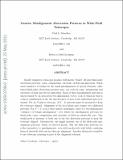Generic Misalignment Aberration Patterns in Wide-Field Telescopes
Author(s)
Schechter, Paul L.; Levinson, Rebecca Sobel
Downloadschechter2.pdf (7.431Mb)
OPEN_ACCESS_POLICY
Open Access Policy
Creative Commons Attribution-Noncommercial-Share Alike
Terms of use
Metadata
Show full item recordAbstract
Axially symmetric telescopes produce well-known Seidel off-axis third-order aberration patterns: coma, astigmatism, curvature of field, and distortion. When axial symmetry is broken by the small misalignments of optical elements, additional third-order aberration patterns arise: one each for coma, astigmatism, and curvature of field and two for distortion. Each of these misalignment patterns is characterized by an associated two-dimensional vector, each of which in turn is a linear combination of the tilt and decenter vectors of the individual optical elements. For an -mirror telescope, 2( - 1) patterns must be measured to keep the telescope aligned. Alignment of the focal plane may require two additional patterns. For = 3 , as in a three-mirror anastigmat, there is a two-dimensional “subspace of benign misalignment” over which the misalignment patterns for third-order coma, astigmatism, and curvature of field are identically zero. One would need to measure at least one of the two distortion patterns to keep the telescope aligned. Alternatively, one might measure one of the fifth-order misalignment patterns, which are derived herein. But the fifth-order patterns are rather insensitive to misalignments, even with moderately wide fields, rendering them of relatively little use in telescope alignment. Another alternative would be to use telescope pointing as part of the alignment solution.
Date issued
2011-07Department
Massachusetts Institute of Technology. Department of Physics; MIT Kavli Institute for Astrophysics and Space ResearchJournal
Publications of the Astronomical Society of the Pacific
Publisher
University of Chicago Press
Citation
Schechter, Paul L., and Rebecca Sobel Levinson. “Generic Misalignment Aberration Patterns in Wide-Field Telescopes.” Publications of the Astronomical Society of the Pacific 123.905 (2011): 812-832.
Version: Author's final manuscript
ISSN
0004-6280
1538-3873